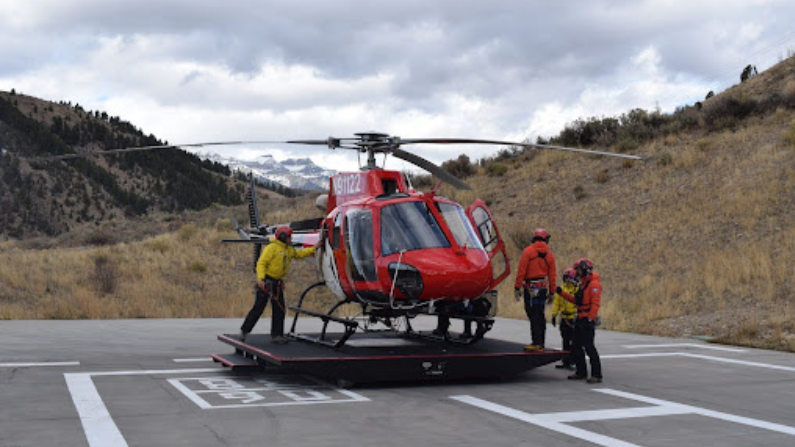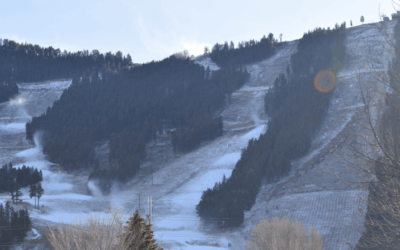With less than an hour until takeoff, six volunteers slip into harnesses and insulated layers at a hanger overlooking Jackson. Carabiners, slings and a good amount of gear and gadgets hang from their hips.
It’s a routine weekly training for Teton County Search and Rescue. This week brings short-haul training, a rescue technique that requires hanging a person from a line directly beneath a helicopter for transport to a safer location.
Thirty minutes until takeoff. The group circled up to go over the plan and any risks they may encounter like weather or hunters and hikers in the area. They decide the potential for something to go wrong is low today. But remember, the helicopter Pilot Steve Wilson said, stay close to the helicopter and away from the rotors.
With fifteen minutes until takeoff helicopter pilot Steve Wilson opens the hangar door, he uses a remote-controlled landing platform, a “heliwagon,” to wheel the custom helicopter outside beneath the patchy clouds. He looks over the multimillion-dollar ride and the other volunteers follow suit, running their hands over all sides of the aircraft from top to bottom and end to end before sliding into their seats.

TCSAR helicopter pilot Steve Wilson opens the hangar door, preparing for training. Wilson flew the “ship” into Jackson in October 2023. (Dante Filpula Ankney / KHOL)
Wilson has worked for TCSAR for six years, but he has been flying for decades. He’s part of the team planned for years to make a helicopter a permanent part of the hangar.
The organization said the new ride was necessary to meet the increase of rescue calls as the county grows and more recreationists file into the backcountry.
“So year round, 365 days a year. We can respond to any needs that this community has,” Wilson said.
Over a year ago, nabbing a helicopter for a rescue could have been simple, if one was under lease. For six years pre-chopper, Search and Rescue leased a helicopter from the U.S. Forest Service to fight wildfires in the summer.
But without a lease, Search and Rescue was occasionally left locating the nearest “ship” via a cascade of phone calls to partners such as the Forest Service. When every minute counts, longer waits mean higher stakes.
Cody Lockhart, chief advisor for TCSAR and a lifelong Jacksonite, has been with the organization for about 15 years.
“Every time we needed one, it was like banging on your neighbor’s door, borrowing a lawnmower,” he said
Now when the bell goes off or the phone rings, the pilot and the helicopter are there, ready.
It’s a new reality that’s unique to the region.
In Colorado, a state that responds to some of the most search and rescue incidents in the U.S., no volunteer Search and Rescue operations have their own helicopter, according to the Colorado Search and Rescue Association.
A representative from the organization said “it’s a money thing,” especially for those without a special foundation.
Teton County’s Search and Rescue Foundation, led by then-executive director Stephanie Thomas, was able to raise over 7 million dollars — in less than a year — to buy their own custom-made search and rescue helicopter in its largest capital campaign ever.

A volunteer packs bags for a short-haul training at the TCSAR facility near the “Y” intersection just west of Jackson. (Dante Filpula Ankney / KHOL)
“There are some economic realities to living in Jackson Hole,” Lockhart said, “the money was here and people were willing to come to the table and pony up.”
The organization flew 67 missions in the first year with the new ride – over double the number of trips in 2023. But rescues themselves didn’t double, Teton County SAR helped other operations that did not have their own helicopter. About half of those missions were in partnership with Grand Teton National Park and the Jenny Lake Rangers.
In the first year, TSCAR has flown missions into Idaho, Colorado and Yellowstone National Park. Rescues outside the county, Lockhart said, happen only when the helicopter is not needed in the county. Others pay to use the helicopter, like a business, which contributes to the its upkeep and maintenance.
“Taxpayers are paying for this helicopter one way or the other,” Lockhart said, “but it helps when we get federal dollars in there, not just county dollars.”
Lockhart says the helicopter not only helps Teton County, but the entire region.
“We definitely saved a bunch of lives,” he said.
Back on the launchpad, pilot Wilson slowly lifts the helicopter with a gust strong enough to knock someone from their feet. About 50 feet up, the helicopter leans, turns and within a minute, becomes a speck.
Wilson says the job is demanding. On duty, he stays 15 minutes away from the facility in case a call comes in. It’s risky at times, like flying in hazardous winter weather. But there are perks.
“I’ve been fortunate enough to fly in some of the most beautiful places on the planet,” Wilson said, “and there’s no better place than here in the Tetons for me.”
Winter is the busiest time for TSCAR. No one is wishing for calls from the backcountry. But, inevitably, when they come in, the new blades will be there.






